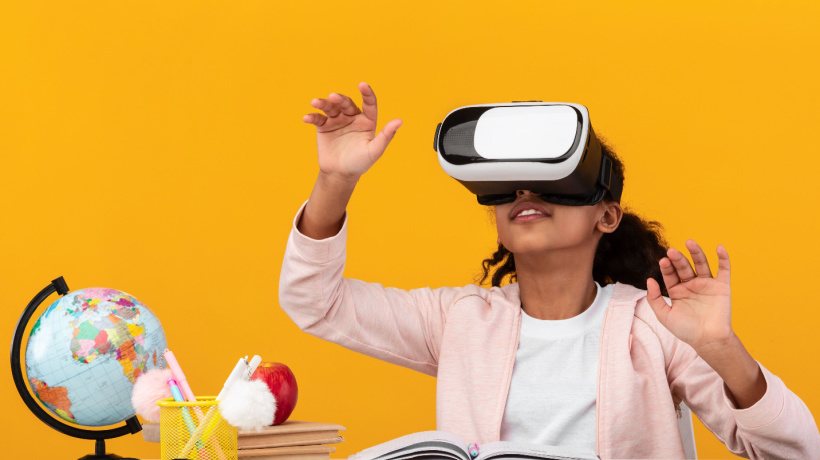Immersive eLearning Experiences With VR And AR
VR and AR provide interactive and immersive learning environments that can engage students and improve knowledge retention. While the beginning investments in AR and VR technologies may need budget allocation, the long-term cost efficiency and growth of eLearning programs using these technologies make them very affordable. As technology continues to evolve, VR and AR are expected to play an extremely significant role in eLearning, providing students with immersive and unique educational experiences. Here’s a closer look at how VR and AR are used in eLearning.
Virtual Reality In eLearning
VR in eLearning refers to the use of engaging virtual environments to deliver educational media and create interactive learning experiences. VR technology allows students to enter a computer-generated 3D world and interact with it using specialized devices, including VR headsets.
- Immersive learning environments
VR creates realistic simulated words that allow students to experience real-world scenarios in a safe and controlled environment. - Experiential learning
VR enables learners to actively take part in learning activities rather than passively take in information. - Virtual field trips
VR can transport learners to diverse locations and historical periods, providing a virtual field trip experience. - Soft-skills development
VR can be used to practice interpersonal skills, such as public speaking or negotiation, in a realistic virtual environment.
Augmented Reality In eLearning
AR in eLearning means the integration of digital information and virtual objects into real-world surroundings to improve the learning experience. AR technology interlays computer-generated elements, such as images, videos, or 3D models, onto the learner’s physical world in real time.
- Real-time information overlay
AR overlays digital material onto the real world, enhancing the learning experience. - Hands-on learning
AR allows learners to interact with virtual objects mixed with their physical surroundings. - Remote collaboration
AR enables students to collaborate remotely and share their point-of-views in a shared augmented space. - Contextual learning
AR can give contextual information and rules based on the learner’s surroundings.
How Immersive VR And AR Experiences Provide Deeper eLearning Engagement
Virtual Reality (VR) and Augmented Reality (AR) offer several advantages when integrated into eLearning environments. Here are some key benefits of using VR and AR in eLearning:
1. Enhanced Engagement And Collaboration
VR and AR create interactive and immersive learning experiences that capture learners’ attention and increase engagement. These technologies’ interactive and realistic nature stimulates curiosity and promotes active participation in the studying process. VR and AR technologies enable learners to collaborate and engage with peers and teachers in virtual or augmented spaces.
2. Experiential And Personal Learning
VR and AR enable students to actively engage with the material and experience learning in a hands-on manner. They can explore virtual worlds, manipulate objects, and complete tasks, allowing for experiential learning and deepening their understanding of complex subjects. VR and AR technologies can collect student interactions and performance data, allowing for personalized learning experiences.
3. Safe Learning Environments With Accessibility And Inclusivity
VR and AR give students a safe and controlled space to practice skills or engage in simulations without real-world consequences. This is particularly great for training in high-risk healthcare, aviation, or emergency response fields. VR and AR can use diverse learning styles. They provide multifaceted experiences that engage visual, auditory, and other kinds of students.
4. Real-World Application And Contextual Learning
VR and AR bridge the gap between theoretical education and its real-world application by providing contextual learning experiences. Students can also apply their knowledge in simulated real-life situations, facilitating a deeper understanding of how concepts exist in practical situations. For example, VR is utilized for medical training, allowing learners and professionals to practice surgery, medical procedures, and patient engagement in realistic virtual environments.
5. Cost And Resource Efficiency
While initial organization costs for VR and AR can be high, they can ultimately result in cost efficiency in the longer run. Virtual and augmented simulations can lower the need for physical equipment, travel expenditure, and other logistical requirements linked with conventional training methods. AR and VR technologies can greatly reduce or eliminate the need for physical materials such as equipment, materials, and more. VR and AR simulations also give students realistic and interactive training experiences, allowing them to practice their skills in a controlled virtual environment.
To Summarize
Learners can use AR or VR apps on mobile devices and wearable technology for various uses, including accessing more information, translations, and interactive elements while grasping concepts in the real world. Irrespective of the need, there are various ways both Virtual and Augmented Reality can be beneficial to learners, teachers, and education systems overall. These innovative technologies have the potential to revolutionize education by providing engaging, interactive, and personalized learning experiences.

